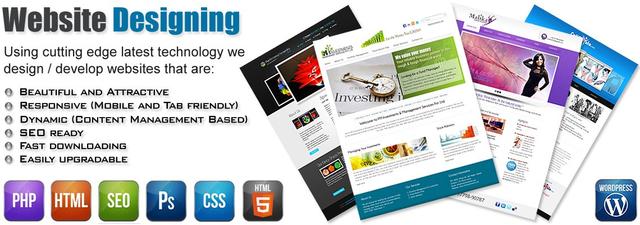The Future of Digital Marketing: Web Design Pretoria Trends to Enjoy
The Future of Digital Marketing: Web Design Pretoria Trends to Enjoy
Blog Article
The Fundamentals of Efficient Web Design for Beginners
Efficient web layout is a complex self-control that considerably impacts individual interaction and satisfaction (Web Design Pretoria). For novices, comprehending the essentials-- such as comprehending user experience, choosing a proper shade combination, and making certain responsive design-- can be daunting yet gratifying.
Understanding Individual Experience

Trick elements of UX include user research study, which helps determine the needs and preferences of the target audience, and use testing, which analyzes just how real customers interact with the site. Intuitive navigating, responsive style, and clear, interesting material are important components that add to a positive user experience.
In addition, the emotional action evoked from individuals during their interactions can substantially influence their perception of the brand name - Web Design Pretoria. An internet site that prioritizes UX fosters depend on and encourages repeat check outs, inevitably driving conversions and customer loyalty. Therefore, recognizing individual experience is not just an option for aiming internet developers; it is a fundamental concept that underpins successful electronic communications and influences the overall efficiency of website design.
Choosing the Right Color Palette
Selecting the ideal color scheme is typically a decisive factor in internet style that can profoundly influence customer assumption and interaction. A well-thought-out color pattern not just improves the visual appeal of a web site yet additionally plays a vital duty in branding and communicating the intended message.
When picking shades, take into consideration the mental effects they carry users. Blue frequently evokes sensations of count on and integrity, while red can boost enjoyment or urgency. Use color theory concepts, such as complementary and comparable color systems, to develop aesthetic harmony.
In addition, ensure that your shade options line up with your target market and sector requirements. Performing customer study can offer beneficial insights right into favored color design that resonate with your group. Additionally, preserving enough contrast between message and background colors is essential for readability and availability, guaranteeing that all customers can navigate your site effortlessly.
Finally, consistency is important; utilize your shade scheme evenly across all pages to reinforce your brand identification. By thoughtfully selecting your color combination, you can develop a compelling customer experience that mesmerizes visitors and motivates them to engage with your material.
Relevance of Responsive Layout
A well-designed website not only captivates with its color palette however likewise adapts effortlessly to numerous tools and display dimensions. Responsive style is important in today's electronic landscape, where customers access the internet via a myriad of devices, consisting of desktops, smart devices, and tablet computers. Web Design Pretoria. An internet site that stops working to adapt to various display sizes risks estranging a significant section of its target market, eventually resulting in greater bounce prices and decreased user involvement
Moreover, online search engine like Google prioritize click this link mobile-friendly internet sites in their ranking algorithms, implying that responsive design is not just an individual experience enhancement but also a vital part of effective search engine optimization (SEO) By making certain that your web site is responsive, you boost functionality, making it simpler for site visitors to interact and browse with your content, no matter the device they are making use of.
Incorporating responsive layout methods, such as fluid grids, flexible photos, and media queries, enables an internet site to keep a attractive and consistent visual across numerous systems. This adaptability not only improves customer satisfaction but additionally fosters brand name integrity and depend on, as customers are extra likely to engage with an internet site that offers a seamless experience.
Navigating Typography Fundamentals
Typography plays a crucial duty in website design, functioning as the aesthetic voice pop over to this site of a site's material. It encompasses the font styles, dimensions, spacing, and overall discussion of text, which considerably affects readability and customer experience. To begin navigating typography fundamentals, it's vital to choose a font that aligns with the brand's tone and message. Serif fonts typically communicate practice and reliability, while sans-serif fonts project modernity and quality.
Next, consider typeface dimension and line elevation. A general policy is to utilize a minimum see font size of 16 pixels for body message to ensure clarity across devices. Sufficient line height, generally 1.5 times the font size, enhances readability by supplying enough area between lines.
In addition, focus on comparison. Text need to attract attention versus its history to avoid pressure on the visitor's eyes. Avoid making use of way too many various font styles; a mix of 2 or 3 can produce an unified style. Keep in mind that typography is not static; test different styles and arrangements to see what resonates ideal with your audience. Mastering typography will certainly raise your web design, making your site not only appealing however user-friendly and likewise useful.

Using Aesthetic Hierarchy
At the core of efficient website design exists the principle of visual pecking order, which overviews users via web content in a way that is both engaging and user-friendly. Aesthetic power structure refers to the arrangement of aspects on a webpage to symbolize their importance with dimension, shade, positioning, and comparison. By using these strategies, designers can lead users' interest to crucial information, enhancing their overall experience.
To establish a clear visual hierarchy, start by determining the most important components on your web page, such as headings, contacts us to action, or images. Use bigger fonts and vibrant colors for primary headings to make them stand apart. Subheadings should be somewhat smaller sized, preserving a sensible flow that routes the customer's look downward.
Furthermore, contrast plays a crucial function; contrasting colors can make important elements pop, while constant spacing develops a tidy design that is simple to navigate. Employing whitespace successfully likewise enhances readability, enabling individuals to concentrate on the web content without really feeling bewildered.
Inevitably, a well-implemented visual hierarchy not just improves user involvement however also promotes far better understanding, making it an essential facet of efficient website design.
Final Thought
In summary, reliable website design for newbies requires an extensive understanding of customer experience, choice of ideal color schemes, and the application of receptive design. Typography fundamentals and a clear visual power structure additionally enhance usability and navigation. Prioritizing these components fosters a setting for user involvement and fulfillment. Inevitably, a well-designed site not only draws in site visitors but likewise promotes recurring interaction, establishing a structure for success in the electronic landscape.

At the core of efficient internet style lies the concept of aesthetic pecking order, which guides users through web content in a means that is both user-friendly and engaging.In recap, effective internet layout for novices demands a thorough understanding of individual experience, selection of suitable color schemes, and the application of responsive layout.
Report this page